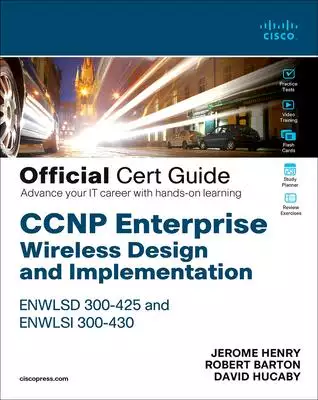IT infrastructure wi的問題,透過圖書和論文來找解法和答案更準確安心。 我們找到下列地圖、推薦、景點和餐廳等資訊懶人包
IT infrastructure wi的問題,我們搜遍了碩博士論文和台灣出版的書籍,推薦Henry, Jerome寫的 CCNP Enterprise Wireless Design and Implementation Enwlsd 300-425 and Enwlsi 300-430 Official Cert Guide: Designing & Implementi 和Pahlavan, Kaveh的 Indoor Geolocation Science and Technology: At the Emergence of Smart World and loT都 可以從中找到所需的評價。
這兩本書分別來自 和所出版 。
國立臺北科技大學 環境工程與管理研究所 申永順、胡憲倫所指導 張簡健利的 我國2050淨零政策下電動自用小客車發展對減碳及環境衝擊之影響 (2021),提出IT infrastructure wi關鍵因素是什麼,來自於淨零排放、電動汽車、減碳效益、系統動力學、動態生命週期評估。
而第二篇論文逢甲大學 智慧城市碩士學位學程 方耀民、周天穎所指導 葉珉辰的 基於UWB人員定位技術提升智慧管理效能之研究 (2021),提出因為有 智慧工廠、室內定位系統、超寬頻、三角測量法的重點而找出了 IT infrastructure wi的解答。
CCNP Enterprise Wireless Design and Implementation Enwlsd 300-425 and Enwlsi 300-430 Official Cert Guide: Designing & Implementi

為了解決IT infrastructure wi 的問題,作者Henry, Jerome 這樣論述:
Jerome Henry (CWNE No. 45, CCIE Wireless No. 24750) is Principal Engineer at Cisco’s Enterprise Infrastructure and Solutions Group. He has 17+ years of experience teaching technical Cisco courses in 15+ countries and in four languages, has 10,000+ hours in the classroom, and has earned the IT Traini
ng Award Best Instructor silver medal. Before joining Cisco, he consulted on and taught heterogeneous networking and wireless integration with the European Airespace team, and spent several years developing networking courses and training materials on emerging technologies for a Cisco Learning partn
er. An IEEE 802.11 Senior Member since 2013, he also participates in Wi-Fi Alliance working groups. Rob Barton (CCIE No. 6660 R&S, Security, CCDE 2013::6, CCDE, CCIE, APEGBC Professional Engineer) is a Distinguished Systems Engineer at Cisco. He has worked in Cisco’s Canada Digital Transformation an
d Innovation Office, and advised Cisco’s IoT business since its inception. He personally led deployment of 2,000,000+ IPv6 smart meters at BC Hydro, Cisco’s largest IoT deployment. A registered Professional Engineer (P. Eng), he has worked in the IT industry for 20+ years, including 16+ at Cisco. He
specializes in Wireless QoS and IT/OT convergence, and is author of IoT Fundamentals. David Hucaby (CCIE No. 4594, CWNE No. 292) is a network engineer for a large university healthcare network based on Cisco wireless products. He holds bachelor’s and master’s degrees in electrical engineering from
the University of Kentucky. Hucaby is author of several Cisco Press titles, including CCNP SWITCH Exam Certification Guide; Cisco LAN Switching Video Mentor; CCNP Security FIREWALL Exam Certification Guide; Cisco ASA, PIX, and FWSM Firewall Handbook, Second Edition; and Cisco Firewall Video Mentor.
我國2050淨零政策下電動自用小客車發展對減碳及環境衝擊之影響
為了解決IT infrastructure wi 的問題,作者張簡健利 這樣論述:
為因應2050年淨零排放目標,臺灣已於2022年3月正式公告國家淨零轉型路徑圖,推動能源、產業、生活及社會四大轉型策略,並提出十二項關鍵策略,其中第七項即為運具電動化及無碳化,然而電動汽車之減排效果在國內尚未獲致完整的論述,因此本研究將依據油井到車輪 (Well-to-Wheel, WTW) 理論,針對以電動汽車取代燃油車並進行生命週期評估 (Life Cycle Assessment, LCA) 之探討。雖然 LCA 是常用的環境衝擊評估工具,但時間因素一直是其發展的挑戰與限制,而系統動力學 (System Dynamics, SD) 能用來模擬具時間變化且複雜性的問題,因此本研究將結合S
D與LCA,以動態生命週期評估法來推估以電動汽車取代燃油車至2050年之減排潛力及降低之環境衝擊。本研究以能源局公告之能源平衡熱值表 (2020) 及溫室氣體排放係數管理表 (6.0.4版) ,計算出臺灣各發電廠之排放係數,以非核家園政策及國家淨零排放路徑據以推估2050年前我國之能源結構變化,並推估出各年度之電力排放係數,進行電動汽車取代燃油車減碳及環境衝擊之計算。在數據蒐集與預測部分是使用系統動力學軟體STELLA來建構系統動力學模型,以推估未來用電量及用油量之變化,配合前述本研究推估之電力排放係數,以及環保署碳足跡資料平台之燃料係數及SimaPro之環境衝擊係數,計算電動汽車之減排潛力及
環境衝擊,並使用openLCA進行蒙地卡羅分析,對其結果進行不確定性分析。此外,本研究亦比較不同再生能源,以及碳捕獲儲存及再利用(CCUS)技術發展情境與結構,探討各情境之減排潛力及環境衝擊。本研究結果顯示,依據我國淨零排放路徑圖之規劃以及本研究能源結構改變之推估,電力排放係數至2050年會下降至0.139 kg CO2e/kWh,較目前0.504 kg CO2e/kWh,顯著下降72%。推動電動汽車有助於臺灣減少碳排放,自2039年後電動汽車的GHG排放量將會隨電力排放係數之降低而逐年降低,總自小客車(含燃油車及電動車)GHG排放將逐年下降,由2020年的1.45×107 tCO2e降至20
50的1.97×106 tCO2e,下降約86%。經本研究生命週期衝擊評估計算得知,電力環境衝擊係數會從2020年的20.2 mPt/kWh降至2050年的5.67 mPt/kWh,減少約72%,但因電動車數量增加而使電力使用量增加之電力環境衝擊會從2020年的1.67×107 Pt提高至2050的2.6×107 Pt,提高約55%。根據不確定性分析結果,在95%信賴區間內,2050年時電動汽車的GHG排放量介於6.359×105 ~ 1.068×106 tCO2e,燃油汽車的GHG排放量介於1.441×106 ~ 3.36×106 tCO2e,電動汽車之減排潛力則介於1.925×106 ~
8.433×106 tCO2e。在本研究以再生能源 (30%~70%) 及CCUS (5%~25%)比例為主要變數之能源情境假設中發現,對環境衝擊最大之情境為再生能源30%且CCUS 5%。當再生能源70%且 CCUS 在25%時電力排放係數最低,所計算出之電動汽車GHG排放亦為最低,減排潛力最大。在總環境衝擊部分,最佳情境為再生能源60%且CCUS 25%。本研究針對電動汽車取代燃油車減碳及環境衝擊之研究結果,可提供國內政府機關、電動車業者及利害關係人,未來制定相關政策、商業決策及研究方向等之參考。
Indoor Geolocation Science and Technology: At the Emergence of Smart World and loT

為了解決IT infrastructure wi 的問題,作者Pahlavan, Kaveh 這樣論述:
Precise and accurate localization is one of the fundamental scientific and engineering technologies needed for the applications enabling the emergence of the Smart World and the Internet of Things (IoT). Popularity of localization technology began when the GPS became open for commercial applicati
ons in early 1990’s. Since most commercial localization applications are for indoors and GPS does not work indoors, the discovery of opportunistic indoor geolocation technologies began in mid-1990’s. Because of complexity and diversity of science and technology involved in indoor Geolocation, this a
rea has emerged as its own discipline over the past two decades. At the time of this writing, received signal strength (RSS) based Wi-Fi localization is dominating the commercial market complementing cell tower localization and GPS technologies using the time of arrival (TOA) technology. Wi-Fi local
ization technology takes advantage of the random deployment of Wi-Fi devices worldwide to support indoor and urban area localization for hundreds of thousands of applications on smart devices. Public safety and military applications demand more precise localization for first responders and military
applications deploy specialized infrastructure for more precise indoor geolocation. To enhance the performance both industries are examining hybrid localization techniques. Hybrid algorithms use a variety of sensors to measure the speed and direction of movement and integrate them with the absolute
radio frequency localization. Indoor Geolocation Science and Technology is a multidisciplinary book that presents the fundamentals of opportunistic localization and navigation science and technology used in different platforms such as: smart devices, unmanned ground and flying vehicles, and existing
cars operating as a part of intelligent transportation systems. Material presented in the book are beneficial for the Electrical and Computer Engineering, Computer Science, Robotics Engineering, Biomedical Engineering or other disciplines who are interested in integration of navigation into their m
ulti-disciplinary projects. The book provides examples with supporting MATLAB codes and hands-on projects throughout to improve the ability of the readers to understand and implement variety of algorithms. It can be used for both academic education, as a textbook with problem sets and projects, and
the industrial training, as a practical reference book for professionals involved in design and performance evaluation. The author of this book has pioneering research experience and industrial exposure in design and performance evaluation of indoor geolocation based on empirical measurement and mod
eling of the behavior of the radio propagation in indoor areas and inside the human body. The presentation of the material is based on examples of research and development that his students have performed in his laboratory, his teaching experiences as a professor, and his experiences as a technical
consultant to successful startup companies.
基於UWB人員定位技術提升智慧管理效能之研究
為了解決IT infrastructure wi 的問題,作者葉珉辰 這樣論述:
隨著第四次工業革命後,許多領域與科技開始結合,人工智慧、5G開始進入到社會中,加上無線通信技術及網際快速發展,以及現在不斷開發室內空間,現今社會中迫切需要高精度和實質性的室內定位服務,如車間材料配送、智慧醫療、智慧家居、大賣場甚至是目前受歡迎的智慧工廠,所有都是室內空間,基於上述的需求,因此產生許多定位技術,從最一開始全球定位系統(GPS, Global Positioning System),雖然不能應用在室內環境,但也為定位技術走出了第一步,之後陸續出現Wi-Fi、RFID(無線射頻)、藍牙、超聲波、紅外線以及ZigBee室內定位。這些定位技術都有各自的優勢,雖然可以滿足許多場域,但依照
目前情況下來看,現行的技術,只能應用在較簡單的場域,應用在較複雜的場域,因為穿透性,以及設備的干擾會造成定位精凖度偏差,無法實現高精度定位。超寬頻(UWB, Ultra-wideband)定位的出現,通過其獨特的脈衝訊號傳送加上由於頻寬較大,因此擁有較好的測距能力,定位精凖度可達公分等級,及具有一定的穿透能力,因此應用在智慧工廠上,是最好的選擇,最終我們也會透過測試不同場域,找出最適合安裝定位基站及放置定位卡片的位置,透過數據回傳至終端伺服器,可以第一時間觀察人員行為,是否有在安全場域,也會調整卡爾曼濾波器(Kalman filter),過濾掉一些突然干擾的訊號,使連續座標出現在地圖上更加順暢
,通過反覆測試尋找最適合的數值,最終透過UWB定位技術提升智慧工廠的產能及效率。本論文,藉由比較人員放置定位卡片及基站設置的位置,經過一系列的嘗試,最終尋找出最適合智慧工廠室內定位的解決方案。關鍵字: 智慧工廠、室內定位系統、UWB、三角測量法